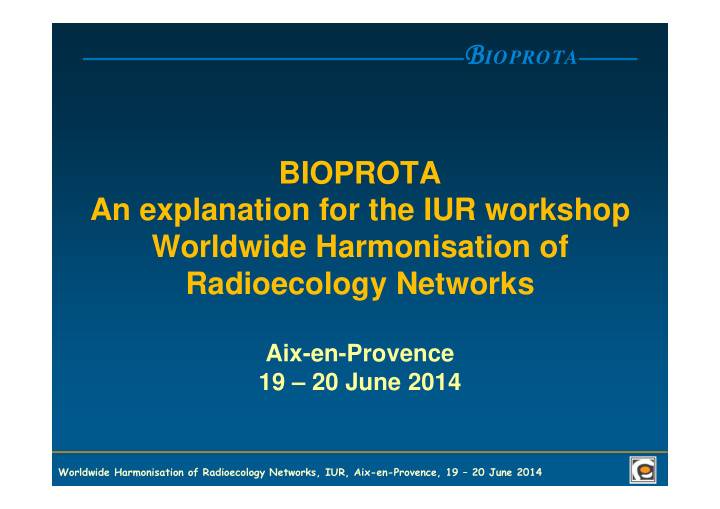



B IOPROTA BIOPROTA An explanation for the IUR workshop Worldwide Harmonisation of Radioecology Networks Aix-en-Provence 19 – 20 June 2014 Worldwide Harmonisation of Radioecology Networks, IUR, Aix-en-Provence, 19 – 20 June 2014
B IOPROTA What is BIOPROTA? An international forum for exchange of information to support resolution of key issues in biosphere aspects of assessments of the long-term impact of contaminant releases associated with radioactive waste disposal Worldwide Harmonisation of Radioecology Networks, IUR, Aix-en-Provence, 19 – 20 June 2014
B IOPROTA Organisation Started in 2002 based on initiative of IRSN (Pascal Santucci) and NRPA Governed by a Concept and Definition Document, updated each year Implementation supported by a Technical Secretariat Sponsoring Committee to monitor the TS Current chairperson; Danyl Pérez-Sánchez, CIEMAT Worldwide Harmonisation of Radioecology Networks, IUR, Aix-en-Provence, 19 – 20 June 2014
B IOPROTA Membership 2013/14 Andra, France KORAD, Korea ARAO, Slovenia LLWR, UK Areva, France Nagra, Switzerland Operators BfS, Germany RWM Limited, UK Regulators CIEMAT, Spain NRPA, Norway EdF, France NUMO, Japan Technical support organisations ENSI, Switzerland NWMO, Canada Academic institutions EPRI, USA Posiva, Finland FANC, Belgium SCK-CEN, Belgium All supported by their own FMBC, Russia SKB, Sweden experts and contractors IRSN, France SSM, Sweden JGC Corporation, Japan Oregon State Univ. USA KAERI, Korea Univ. Life Sciences, Oslo Worldwide Harmonisation of Radioecology Networks, IUR, Aix-en-Provence, 19 – 20 June 2014
B IOPROTA Biosphere Assessment Problem Assessment period extends thousands of years into future!!! Empirical analysis of historic releases, helpful but often for the wrong radionuclides and always not long enough time series, so not a complete solution Prognostic assessment with models is difficult: – environmental change – human behaviour not easily assumed, but affects: • modes of exposure, and • modifies environmental change Worldwide Harmonisation of Radioecology Networks, IUR, Aix-en-Provence, 19 – 20 June 2014
B IOPROTA Key Objectives Help make available and share the best sources of information to justify modelling assumptions Focus on key uncertainties for important radionuclides and processes Develop a scientific basis for removing {potentially} unnecessary conservatism Worldwide Harmonisation of Radioecology Networks, IUR, Aix-en-Provence, 19 – 20 June 2014
B IOPROTA Method of Work Annual meetings to share latest progress and raise new key (special) issues 2014 was in London 2015 will be in Madrid Topical workshops to review special issues Mechanism for developing projects among organisations with shared interest in further focussed research on the special issues Worldwide Harmonisation of Radioecology Networks, IUR, Aix-en-Provence, 19 – 20 June 2014
B IOPROTA Example Special Workshops Evaluation of Primary Features, Events and Processes Occurring in the Geosphere-Biosphere Interface Zone C-14 model review and comparison Cl-36 in the Biosphere Se-79 in the Biosphere Environmental behaviour of Radium Methodologies for Assessing Radiation Impacts on Non- Human Biota from Radioactive Waste Disposal Facilities Scientific Basis for Long-term Radiological and Hazardous Waste Disposal Assessments Worldwide Harmonisation of Radioecology Networks, IUR, Aix-en-Provence, 19 – 20 June 2014
B IOPROTA Initial Special Projects Model Review and Comparison for the Spray Irrigation Pathway Modelling the Inhalation Exposure Pathway Application of Biotic Analogue Data Model Inter-comparison with Focus on Radionuclide Accumulation in Soil Focus on long-term accumulation effects on dose and emergence from below (weapons fall out deposition data not very relevant) Worldwide Harmonisation of Radioecology Networks, IUR, Aix-en-Provence, 19 – 20 June 2014
B IOPROTA Focus Shift to Key Radionuclides C-14 Long-Term Dose Assessment in Terrestrial Agricultural Ecosystem: FEP Analysis, Scenario Development, and Model Comparison Modelling the Behaviour of Se-79 in Soils and Plants Investigation of Cl-36 Behaviour in Soils and Uptake into Crops Long-term Dose Assessments for U-238 Series Radionuclides Worldwide Harmonisation of Radioecology Networks, IUR, Aix-en-Provence, 19 – 20 June 2014
B IOPROTA Other Special Projects Non-human Biota Dose Assessment: Sensitivity Analysis and Knowledge Quality Assessment Demonstrating Compliance with Protection Objectives for Non-Human Biota within Post- closure Safety Cases for Radioactive Waste Repositories Human Intruder Dose Assessment for Geological Disposal Worldwide Harmonisation of Radioecology Networks, IUR, Aix-en-Provence, 19 – 20 June 2014
B IOPROTA On-going Projects Modelling Approaches to C-14 in Soil-Plant Systems and Aquatic Environments, and Scope for Validation Methodology for addressing transfer across the Geosphere-Biosphere Interface, allowing coherently for environmental change in the geosphere and biosphere Temporal and spatial scales for assessment of doses to Non-Human Biota Worldwide Harmonisation of Radioecology Networks, IUR, Aix-en-Provence, 19 – 20 June 2014
B IOPROTA Overview All is done in spirit of collaborative scientific investigation Results are presented as potentially helpful information, not as recommendations or as a collective opinion A substantial body of results has been produced, all available at www.bioprota.org It is hoped that BIOPROTA is an effective model for sharing resources to address commonly identified problems Worldwide Harmonisation of Radioecology Networks, IUR, Aix-en-Provence, 19 – 20 June 2014
More recommend